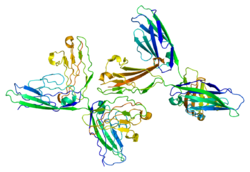
Neural cell adhesion molecule

2E3V, 2HAZ, 2VKW, 2VKX, 3MTR, 5AEA468417967ENSG00000149294ENSMUSG00000039542P13591P13595NM_181351NM_000615NM_001076682NM_001242607NM_001242608NM_001081445NM_001113204NM_010875NM_001311065NP_000606NP_001070150NP_001229536NP_001229537NP_851996NP_001074914NP_001106675NP_001297994NP_035005Neural cell adhesion molecule (NCAM), also called CD56, is a homophilic binding glycoprotein expressed on the surface of neurons, glia and skeletal muscle. Although CD56 is often considered a marker of neural lineage commitment due to its discovery site, CD56 expression is also found in, among others, the hematopoietic system. Here, the expression of CD56 is most stringently associated with, but certainly not limited to, natural killer cells. CD56 has been detected on other lymphoid cells, including gamma delta (γδ) Τ cells and activated CD8+ T cells, as well as on dendritic cells. NCAM has been implicated as having a role in cell–cell adhesion, neurite outgrowth, synaptic plasticity, and learning and memory.1epf: CRYSTAL STRUCTURE OF THE TWO N-TERMINAL IMMUNOGLOBULIN DOMAINS OF THE NEURAL CELL ADHESION MOLECULE (NCAM)1lwr: Solution structure of the NCAM fibronectin type III module 21qz1: Crystal Structure of the Ig 1-2-3 fragment of NCAM2e3v: Crystal structure of the first fibronectin type III domain of neural cell adhesion molecule splicing isoform from human muscle culture lambda-4.42haz: Crystal structure of the first fibronectin domain of human NCAM12ncm: NEURAL CELL ADHESION MOLECULE, NMR, 20 STRUCTURES3ncm: NEURAL CELL ADHESION MOLECULE, MODULE 2, NMR, 20 STRUCTURES Neural cell adhesion molecule (NCAM), also called CD56, is a homophilic binding glycoprotein expressed on the surface of neurons, glia and skeletal muscle. Although CD56 is often considered a marker of neural lineage commitment due to its discovery site, CD56 expression is also found in, among others, the hematopoietic system. Here, the expression of CD56 is most stringently associated with, but certainly not limited to, natural killer cells. CD56 has been detected on other lymphoid cells, including gamma delta (γδ) Τ cells and activated CD8+ T cells, as well as on dendritic cells. NCAM has been implicated as having a role in cell–cell adhesion, neurite outgrowth, synaptic plasticity, and learning and memory. NCAM is a glycoprotein of Immunoglobulin (Ig) superfamily.At least 27 alternatively spliced NCAM mRNAs are produced, giving a wide diversity of NCAM isoforms. The three main isoforms of NCAM vary only in their cytoplasmic domain: The extracellular domain of NCAM consists of five immunoglobulin-like (Ig) domains followed by two fibronectin type III (FNIII) domains. The different domains of NCAM have been shown to have different roles, with the Ig domains being involved in homophilic binding to NCAM, and the FNIII domains being involved signalling leading to neurite outgrowth. Homophilic binding occurs between NCAM molecules on opposing surfaces (trans-) and NCAM molecules on the same surface (cis-)1. There is much controversy as to how exactly NCAM homophilic binding is arranged both in trans- and cis-. Current models suggest trans- homophilic binding occurs between two NCAM molecules binding antiparallel between all five Ig domains or just IgI and IgII. cis- homophilic binding is thought to occur by interactions between both IgI and IgII, and IgI and IgIII, forming a higher order NCAM multimer. Both cis- and trans- NCAM homophilic binding have been shown to be important in NCAM “activation” leading to neurite outgrowth.
